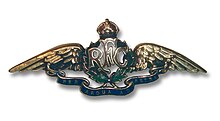R.F.C.
| Royal Flying Corps | |
|---|---|
 |
|
| Active | 13 April 1912 – 1 April 1918 |
| Disbanded | merged into Royal Air Force (RAF), 1918 |
| Country |
|
| Allegiance | King George V |
| Branch |
|
| Size | 3,300 aircraft (1918) |
| Motto(s) |
Latin: Per Ardua ad Astra "Through Adversity to the Stars" |
| Wars | First World War |
| Commanders | |
| Notable commanders |
Sir David Henderson Hugh Trenchard |
| Insignia | |
| Roundel |  |
| Flag |  |
The Royal Flying Corps (RFC) was the air arm of the British Army before and during the First World War, until it merged with the Royal Naval Air Service on 1 April 1918 to form the Royal Air Force. During the early part of the war, the RFC supported the British Army by artillery co-operation and photographic reconnaissance. This work gradually led RFC pilots into aerial battles with German pilots and later in the war included the strafing of enemy infantry and emplacements, the bombing of German military airfields and later the strategic bombing of German industrial and transport facilities.
At the start of World War I the RFC, commanded by Brigadier-General Sir David Henderson, consisted of five squadrons – one observation balloon squadron (RFC No 1 Squadron) and four aeroplane squadrons. These were first used for aerial spotting on 13 September 1914 but only became efficient when they perfected the use of wireless communication at Aubers Ridge on 9 May 1915. Aerial photography was attempted during 1914, but again only became effective the next year. By 1918, photographic images could be taken from 15,000 feet and were interpreted by over 3,000 personnel. Parachutes were not available to pilots of heavier than air craft in the RFC – nor were they used by the RAF during the First World War – although the Calthrop Guardian Angel parachute (1916 model) was officially adopted just as the war ended. By this time parachutes had been used by balloonists for three years.
...
Wikipedia
